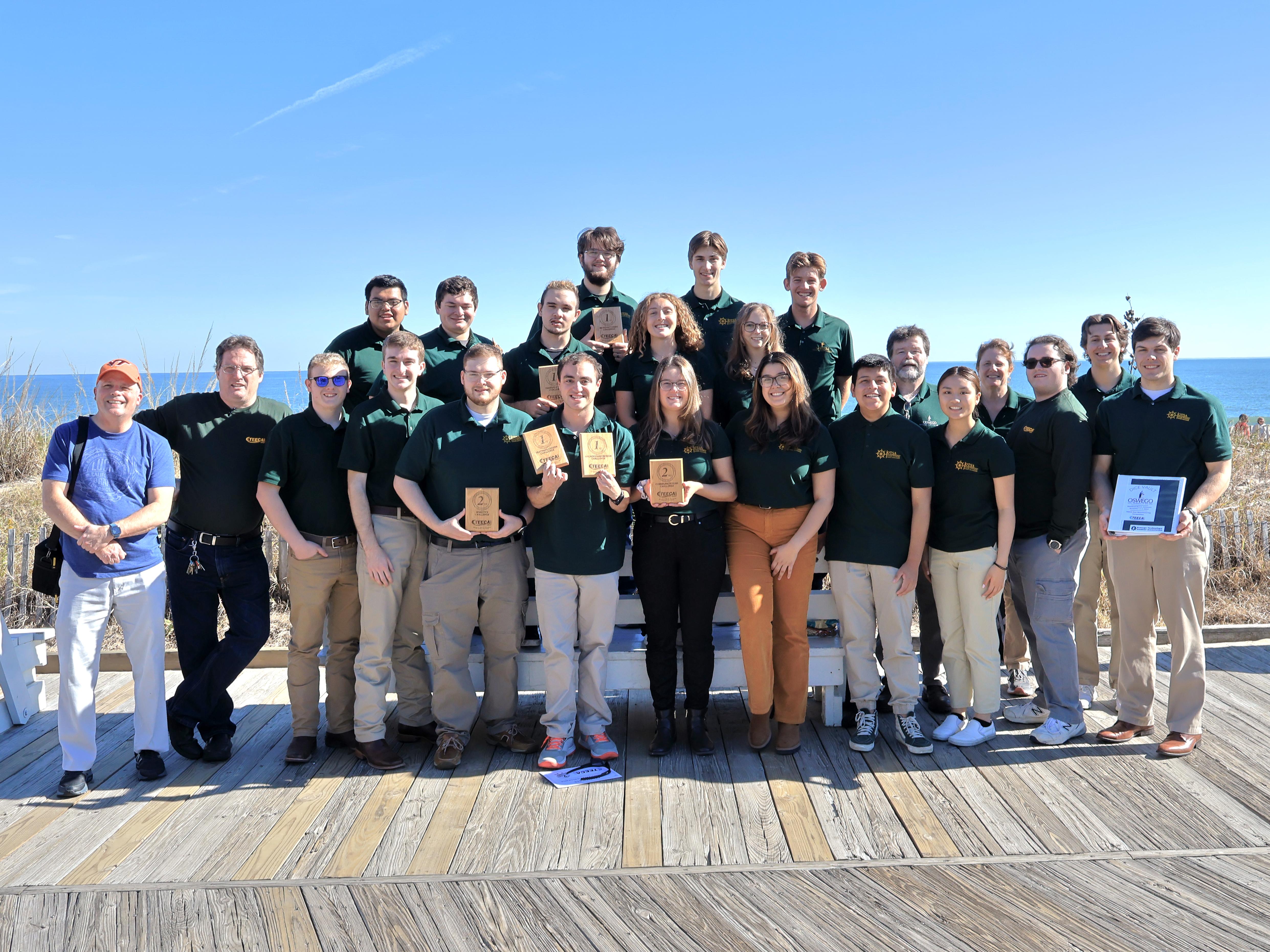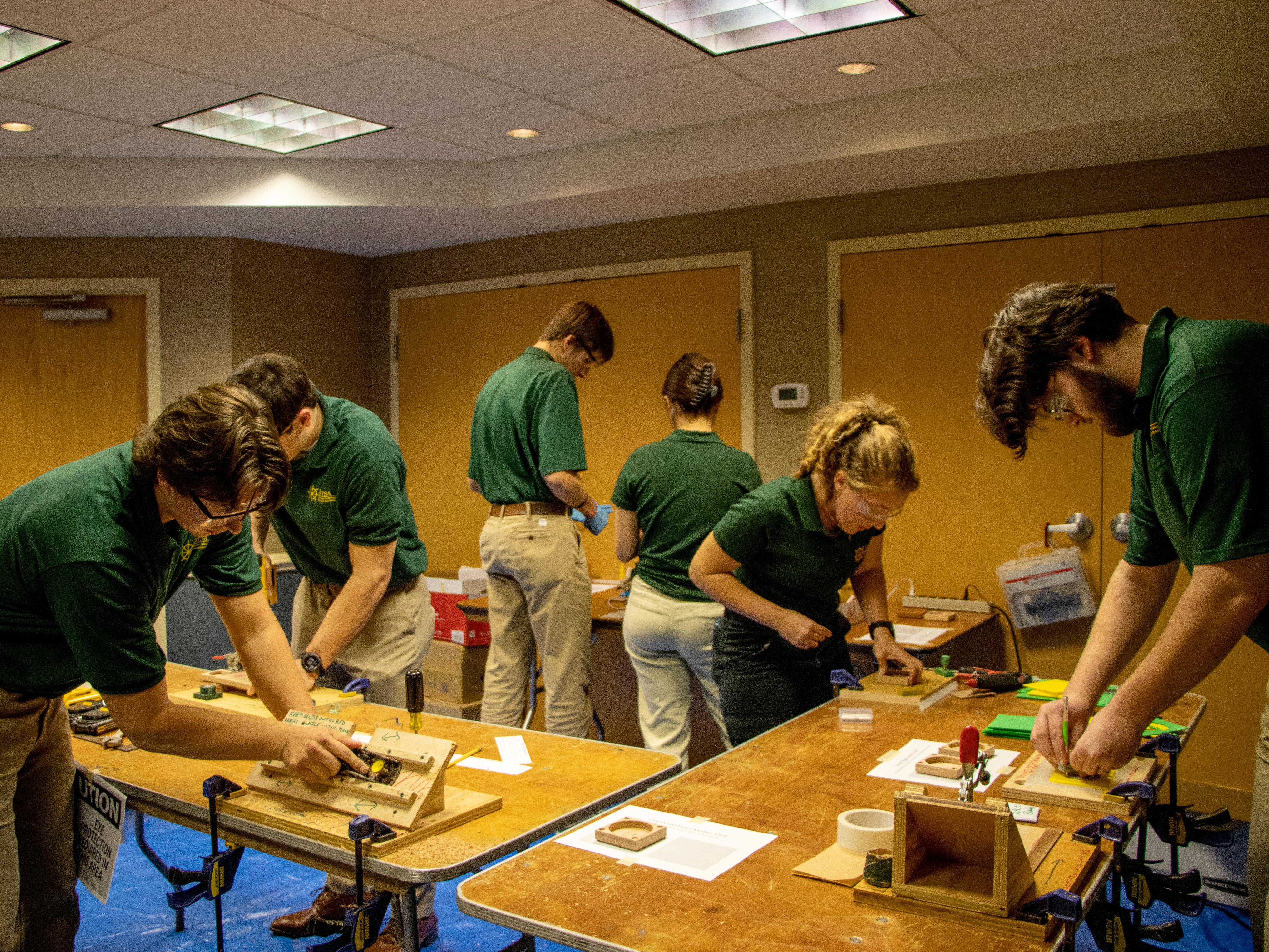SUNY Oswego technology students work toward a first-place finish in the TEECA Manufacturing competition. From left are Jack Donohue, Joseph Costello, Andrew Anderson, Tiffany Truong, Bryleigh Beauchat and Daniel Hall.
SUNY Oswego technology students continued to shine in conference competitions, adding a half-dozen honors recently at the TEECA (Technology and Engineering Education Collegiate Association) East Conference in Rehoboth Beach, Delaware.
Oswego students took first place in four competitions –- Manufacturing, Teaching Challenge, Arcade Design and Transportation –- and added second-place finishes in Robotics and Communications.
Bryleigh Beauchat, a senior technology education major, said the latest showing reflects a lot of hard work by members of the Oswego Technology Student Association and technology professors, but plenty of fun as well.
“We all worked very hard for each conference but also in working to grow the program,” Beauchat said. “We’ve been growing and growing and it’s been very successful. Yes, the competitions are important but it’s very good that we can make those connections and meet people from other schools.”
The Manufacturing competition is especially challenging since all work takes place on-site with only an hour to produce. Teams had to manufacture six dice, instructions, magnetic enclosures and pressed inlays on top. In addition to Beauchat, Oswego’s team included Andrew Anderson, Joe Costello, Jack Donohue, Daniel Hall and Tiffany Truong.
“I felt like we did a fantastic job, and there was such fantastic energy in there,” Beauchat said. “I can’t say enough about how great we worked together as a team.”
The Arcade Design was especially fun and the resulting two full-size arcade games also are available to the campus community in the Technology Department office in Park Hall during regular business hours.
“We had to use a Makey-Makey to make an arcade machine,” said Adam Parente, a senior technology education major who built the machines along with Tristan Spinelle. “People can use it to play Pac-Man, Space Invaders, Galaga and Asteroids.”
A grant from the campus RISE (Research and Individualized Student Experiences) program helped them learn about the correct circuit boards, and they decided to buy enough materials to create two. “We worked on them every day and on the weekends, probably for a good three or four weeks,” Parente said.
“They put in an amazing amount of work,” Beauchat said.
The Teaching Challenge requested competing teams select a microcontroller interface and then develop and share a lesson plan on why that option was preferable. Parente, who completed the challenge with Spinelle, said the Oswego team selected Arduino, an open-source prototyping platform allowing users to create interactive electronic objects.
“We had only 15 minutes to present, but we had to prepare a whole lesson plan,” Parente said, noting that making the activity more interactive helped them succeed, as “something that made us stand out from the competition was that we gave the judges something to do.”
The Transportation competition required teams to create a device that could sort electrical caps into different colors and sizes, using a conveyor belt, Lego Mindstorms and their own ingenuity. Simon Baker and Sam Gosden stepped up in this challenge.
The ambitious Communications challenge involved documenting conference activities, from preparation to competition.
“We filmed people getting ready for the competition, the bus ride, the stops along the way, the hotel, all the experiences,” said Eliza Sarigiannis, a senior technology education major, who was on the team with Ethann Browne, Caitlin Fay and Gillian Lopez. “We had to film what TEECA was all about. All the editing happened at the conference.”
“We stayed up the entire night to get it done in about 36 hours,” said Lopez, a freshman technology education major. “We had three freshmen, including me, on the team. It was our first time learning Adobe Premiere Pro, just learning as we go.”
For the Robotics competition, the Oswego team of Daniel Hall, Ever Hernandez and Samuel Solomon had to create a robot that could navigate a course, pick up balls and carry them, as well as “score” into a net for the other side.
“They worked really hard and just had a good time,” Beauchat said. “That was a theme this year. We’re all super-competitive and I think that’s what drove us.”
And while a team of mostly conference newcomers –- Bryan Diaz-Ximello, Ryan Hoffman and Joey Seybolt Jr. –- did excellent work in the Problem-Solving exercise, even if they did not place in the top three, it provided a learning experience. “They had to make a conveyor belt to deliver Rollos. It was a really hard prompt,” Beauchat said. “That includes robotics and so many other aspects. They still did very well. Some judges said Oswego had the most creative approach to the challenge.”
Students' participation was made possible by the Feinberg Family Fund. The fund was originally created in 2003 by Robert Feinberg ’78 and his wife, Robbi, and it has grown to support SUNY Oswego students who are seeking professional development experiences related to their academic and career goals. Individuals may apply for up to $500 for internship/co-op expenses, and up to $250 for conference registrations or professional certifications. Students who would like to utilize the Feinberg Fund should contact the EXCEL Office at excel@oswego.edu or visit EXCEL's professional development and funding opportunities website.
Faculty support
Participants all agreed that the support of Oswego faculty inside and outside of the classroom were key to their ongoing success.
“This is the most professors we’ve ever had come to a conference,” Beauchat said, noting that faculty members Richard Bush, Karin Dykeman, Mark Springston and Ronald Alexander all attended and provided guidance during the conference. “They always have an answer, and if they don’t, they’ll work there with us. They work hard and they’re willing to travel with us and hang out with us.”
“We owe a big thank you to Mark Springston, who drove both arcade machines to Delaware,” Parente said. “He helped us big time with that, and he really pushed us to get the Makey-Makey.”
Even professors who couldn’t attend were instrumental in the success. “Every manufacturing project goes back to things we’ve done in one of Dan Tryon’s classes,” Beauchat said. “We were able to accomplish what we had to do because we’ve learned through his classes. He guides us without telling us the answer but instead encourages critical thinking, which is so important in this field.”
Another faculty member, Mark Hardy, helped with the electronics for the Arcade challenge, Parente said.
“Some of us freshmen didn’t know a lot of people going in, but we got to make a lot of connections,” Lopez said. “I haven’t had a lot of the professors yet or taken many classes but it was great to see things and connect with professors I know I will have down the line. I’ll feel a lot more confident when I take their classes.”
The awards at this TEECA add to a trophy case that includes multiple awards at the 2023 ITEEA (International Technology and Engineering Educators Association) national conference, the 2022 TEECA Regional Conference and the 2022 ITEEA National Conference.
With many seniors participating in a regional conference for the last time after building so much recent success, the experience was a little bittersweet, but Beauchat sees a bright future with so many others participating, especially with such a large freshmen turnout.
“For many of us, this was our last conference, but we enjoyed having a lot of newer students participate and getting to see them experience their first conference,” Beauchat said.
“It was great to see many freshmen and sophomores getting into it and getting excited,” Sarigiannis added.
For more information on SUNY Oswego's Technology Department and its academic programs, visit oswego.edu/technology.





